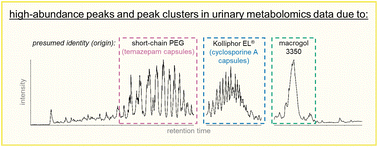High-abundance peaks and peak clusters associate with pharmaceutical polymers and excipients in urinary untargeted clinical metabolomics data: exploration of their origin and possible impact on label-free quantification†
Abstract
Pharmaceutical polymers and excipients represent interesting but often overlooked chemical classes in clinical exposure and bioanalytical research. These chemicals may cause hypersensitivity reactions, they can be useful to confirm exposure to pharmaceuticals, and they may pose bioanalytical challenges, including ion suppression in liquid chromatography-mass spectrometry (LC-MS-)based workflows. In this work, we assessed these chemicals in light of a rather surprising finding presented in two previously published studies, namely that usage of cyclosporine A, an immunosuppressive drug which is known to be cleared through excretion in the bile, explained the largest amount of variance in principal component analysis of urinary LC-SWATH/MS small-molecule profiling data. Specifically, we examined the freely-accessible 24-hour urine metabolomics data of 570 kidney transplant recipients included in the TransplantLines Biobank and Cohort Study (NCT03272841). These data unveiled thousands of high-abundance polymer peaks in some samples, which were associated with the use of the macrogol (i.e., polyethylene glycol) 3350 oral laxative agent. In addition, we found multiple clusters of high-abundance peaks which were linked to the exposure to two pharmaceutical excipients, namely short-chain polyethylene glycol (molecular weight <1000 Da) and polyethoxylated castor oil (also known as Kolliphor® EL or Cremophor® EL). Respectively, these excipients are used in temazepam capsules and cyclosporine A capsules, and the latter provides a plausible explanation for the rather surprising finding that instigated our work. Moreover, such explanation and our findings in general put emphasis on taking into consideration these and other pharmaceutical polymers and excipients when exploring, processing, and interpreting clinical small-molecule profiling data.

- This article is part of the themed collection: 150th Anniversary Collection: Metabolomics


 Please wait while we load your content...
Please wait while we load your content...